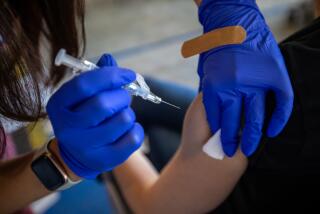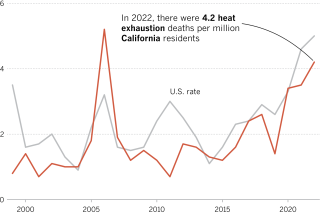Getting Burned
- Share via
Since 1973, the rate of melanoma, the deadliest form of skin cancer, has increased by 4% each year, according to the American Cancer Society. The most recent state figures available show that 802 Californians--including 185 people in Los Angeles County--died of melanoma in 1991. Aside from melanoma, people can also contract basal cell or squamous cell cancers, which are highly curable, but usually with surgery.
Although the depleted ozone layer is placing everyone at greater risk for skin cancer, there are some precautions that can be taken.
Tips on Sun Exposure
* Stay out of the sun between 10 a.m. and 3 p.m., when the rays are the strongest.
* Use sunscreen with a sun protection factor (SPF) of 15 or stronger; and one that protects against both UV-A and UV-B rays.
* Use a waterproof sunscreen if you plan to be in the water or expect to perspire heavily.
* Sunburns received from infancy to teen years can increase the risk of contracting melanoma as an adult.
* Wear a wide-brimmed hat and clothes with a tight weave.
* If you’ve been using a self-tanning product, you still need to use sunscreen when you’re in the sun.
* Temperature has little to do with sun exposure. Ultraviolet radiation is strong on relatively cool days and can penetrate clouds.
Warning Signs
Changes in moles can be an early warning sign of skin cancer, so the American Cancer Society recommends that adults examine their skin once a month. People who have atypical moles are considered to be at a higher risk of getting melanoma. Check the “A,B,C and D” of moles:
* A is for asymmetry, when both halves of the mole don’t match each other.
* B is for border, when the border is ragged, blurred or irregular.
* C is for color, when the color of the mole is not the same throughout or has shades of tan, brown, black, red, white or blue.
* D is for diameter, if the diameter of the mole is larger than a pencil eraser. Changes in moles should be reported to a dermatologist.
Skin Cancer Statistics
How melanoma compares with other types of cancer: (estimated cancer cases for 1994)
In the United States:
Total 1,208,000
Prostate: 200,000
Female breast: 182,000
Lung: 172,000
Colon and rectum: 149,000
Uterine: 46,000
Melanoma: 32,000
Oral: 29,600
Leukemia: 28,600
Pancreatic: 27,000
In California
Total: 124,000
Female breast: 19,000
Prostate: 18,000
Lung: 17,000
Colon and rectum: 14,000
Uterine: 5,000
Melanoma: 4,000
Oral: 3,300
Leukemia: 3,100
Pancreatic: 2,900
Skin Cancer Deaths
Deaths expected to occur in 1994 from melanoma:
6,900 nationwide
900 in California
*Other, less common cancer types are included in the total, but not listed specifically.
Treating Sunburns
The treatment of sunburns is the same for all first-degree burns:
Soak the affected area for 15 minutes in cold water (not ice water) or apply a cold compress. Applying aloe vera will cool the burn. Anti-inflammatory pain medicine, such as aspirin or ibuprofen, may also help, as well as hydro-cortisone creams.
There are other topical creams available, but some people can develop sensitivities to them. If you are sunburned all over, consider taking a bath with a cup of dry instant oatmeal scattered in the water. Other physicians have recommended adding vinegar or milk to the water. Second-degree sunburns result in blisters, which might mean a trip to the dermatologist’s office if pain persists for more than a day.
How the Skin Tans
1. The epidermis is penetrated by rays, reaching the underlying dermis.
2. Blood vessels dilate and more blood flows to near the surface.
3. Rays stimulate certain cells to produce more melanin, the skin pigment that darkens the skin.
*
Sources: California Department of Health Services, American Cancer Society, American Academy of Dermatology and the Wellness Encyclopedia.
*
Research by STEPHANIE STASSEL / Los Angeles Times






